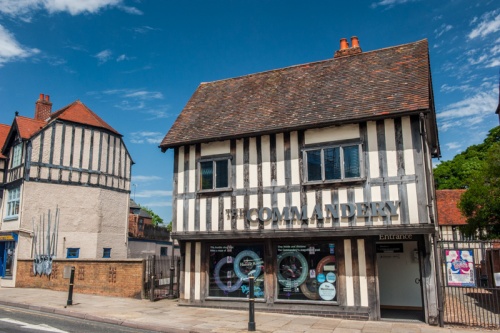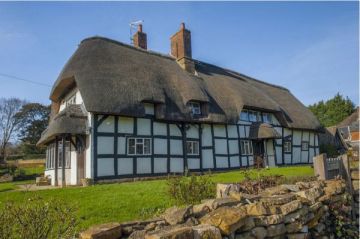
One of the best-preserved historic buildings in Worcester, the Commandery is an intriguing half-timbered Tudor house on the site of an 11th century hospital founded by St Wulfstan and an earlier Saxon chapel founded by St Gudwal. The hospital was one of the last monastic foundations to be dissolved by Henry VIII in the Reformation.
The Commandery is most associated for its role in the Civil War, when it was used by Charles II as his headquarters before the Battle of Worcester in 1651.
The complex of buildings now houses a museum of Worcester history, with displays on the art, social history, ethnology, archaeology, geology, and natural history of the area, and exhibits from the Worcestershire Regiment and the Worcestershire Yeomanry Cavalry.

History
Some time in the late Saxon period a chapel was erected here, dedicated to St Gudwal. Remains of pillars used in St Gudwal's chapel can be seen in the garden. Then around AD 1085 St Wulstan, Bishop of Worcester, founded a hospital on the site of the earlier chapel. The hospital was situated just outside the medieval city gates, where major roads from Bristol, Bath, and London converged, so it probably was intended to serve the needs of travellers. It is highly likely that the hospital was founded by, or for, the Knights Hospitallers, who usually called their administrative districts commanderies.
Most of the present building dates to the 15th century and is a wonderful example of late medieval timber-framing. It seems that an anonymous donor gave a large sum of money to the hospital, enough to finance a complete rebuilding of the Norman buildings, which must by then haven showing their age. Itappears that the earlier structure was completely destroyed, except for St Gudwal's chapel, and a new timber-framed structure erected.
The large timber pieces were assembled in a builder's yard, marked, and taken appart for transport to the building site where they were reassembled. So in essence, the Commandery as we see it today was a gigantic flat-pack building. You can see the carpenter's marks on beams throughout the building, identifying which pieces fit with which other pieces.
The hospital was among the last monastic institutions in England to be disolved by Henry VIII, ending almost 500 years of service in 1540. It passed into private hands and was adapted to a number of roles, including a private dwelling. Immediately after the Dissolution the property was purchased by the Wylde family, wealthy clothiers who owned it until 1785. during the Civil War the Wylde's made their house available to Charles II to serve as his administrative headquarters. When the Wylde's sold the property in 1785 it was split into several dwellings. Then in the 19th century it became a school for the blind, and in the 20th century was used as a printing works.

Highlights
The Great Hall
The heart of the medieval building, where meals would have been eaten and most daily activities have taken place. At one end of the hall is a gallery, overlooking the open space below. Under the gallery is a beautifully carved wooden panel.
The Painted Chamber
In 1935 an amazing discovery was made in a small chamber overlooking the great hall. A series of wall paintings were uncovered, with scenes from the Bible and lives of saints. One very vivide scene depicts the martyrdom of Thomas Becket at Canterbury.
Why were these exceptional wall paintings created in this one small room? One theory is that the chamber was used to house terminally ill pilgrims, and the pictures were supposed to be a reminder of life eternal. So the Painted Chamber was really a chamber for the dying.
The Worcester Funeral Pall
In the Death and Loss Room on the ground floor is a magnificent funeral pall, crafted by the Clothiers Guild of worcester around 1490. The pall is made of embroidered velvet, fringed with silk and created with gold and coloured silk thread. The Pall was used to drape over the coffins of Guild members during funeral processions.
The design is made up of strips of cloth cut from priest's robes; an early form of recycling. The strips depict Biblical scenes, episodes from the lives of saints , and the lives of prophets. According to tradition the Pall wasused top drape the coffin of Prince arthur when he ws buroied at Worcester Cathedral, but this seems unlikely. The light in this room is kept quite low to avoid damage to the 500 year-old fabric.
The Death and Loss Room has strong links to the Civil War Battle of Worcester. William, Duke of Hamilton, was a general in the army of Charles II, and made his headquarters at The Commandery before the battle. Hamilton was wounded defending Red Hill, and was carried back to the Commandery and laid in this room.
Infection from the wound to his leg spread quickly, and Hamilton died in the room. His body was hastily buried under the floor, and only later was it transferred to the cathedral for a proper burial.
Visiting
Wow. That's my one-word summary of visiting the Commandery. From the outside the building looks small, a very simple timber-framed cottage beside the canal, but once you start exploring the maze of rooms and wings that stretch out behind the narrow frontage you start to realize what a complex building this is.
For me, the undoubted highlight is the Painted Chamber. I've rarely seen such a vibrant, exquisitely executed series of historic wall-paintings. Another highlight is the great hall, with its soaring timber roof. Leading off the hall is a beautifully carved Jacobean staircase leading to the upper floor. Perhaps the most poignant room was the Death and Loss Room.
About The Commandery
Address: Sidbury,
Worcester,
Worcestershire,
England, WR1 2HU
Attraction Type: Museum
Location: South-east of Worcester Cathedral, beside Sidbury Lock on the River Severn
Website: The Commandery
Email: commandery@worcestershire.gov.uk
Location
map
OS: SO853 544
Photo Credit: David Ross and Britain Express
HERITAGE
 We've 'tagged' this attraction information to help you find related historic attractions and learn more about major time periods mentioned.
We've 'tagged' this attraction information to help you find related historic attractions and learn more about major time periods mentioned.
Historic Time Periods:
Find other attractions tagged with:
Charles II (Person) - Civil War (Architecture) - Tudor (Time Period) -
NEARBY HISTORIC ATTRACTIONS
Heritage Rated from 1- 5 (low to exceptional) on historic interest
Worcester Cathedral - 0.1 miles (Cathedral) ![]()
Tudor House - 0.1 miles (Historic Building) ![]()
Museum of Royal Worcester - 0.2 miles (Museum) ![]()
The Greyfriars - 0.2 miles (Historic Building) ![]()
Worcester Guildhall - 0.3 miles (Historic Building) ![]()
Worcester, St Swithun's Church - 0.4 miles (Historic Church) ![]()
Worcester City Museum and Art Gallery - 0.6 miles (Museum) ![]()
George Marshall Medical Museum - 1.5 miles (Museum) ![]()
Nearest Holiday Cottages to The Commandery:
Worcester, Worcestershire
Sleeps: 6
Stay from: £710.00 - 2906.00
Callow End, Worcestershire
Sleeps: 4
Stay from: £460.00 - 1785.00
Lower Broadheath, Worcestershire
Sleeps: 6
Stay from: £523.00 - 2318.00
More self catering near The Commandery









